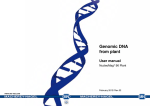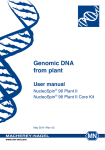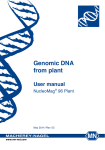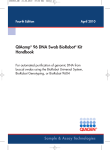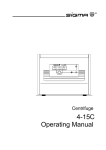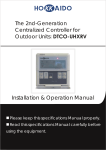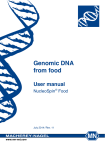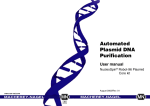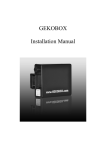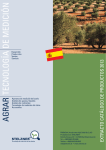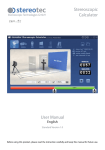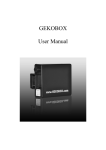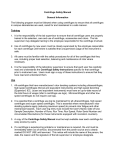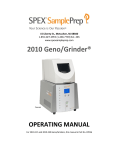Download Genomic DNA from Food
Transcript
Genomic DNA
from Food
User manual
NucleoSpin® 8 Food
NucleoSpin® 96 Food
March 2007 / Rev. 02
www.mn-net.com
MACHEREY-NAGEL
MN
MACHEREY-NAGEL
EN ISO 9001: 2000
CERTIFIED
MACHEREY-NAGEL
MN
Genomic DNA from Food
Table of contents
1 Kit contents
4
2 Product description
6
2.1 The basic principle
6
2.2 Kit specifications
7
2.3 Required hardware
8
2.4 Elution procedures
9
2.5 Automation
9
2.6 Storage and homogenization of samples
10
3 Storage conditions and preparation of working solutions
11
4 Safety instructions – risk and safety phrases
13
5 General Procedure NucleoSpin® 8/96 Food
14
5.1 Important information and advice
14
5.2 Table of positive tested samples (PCR)
15
5.3 General procedure (overview)
16
®
18
5.4 NucleoSpin 8 Food Protocol – purification of DNA under centrifugation
5.5 NucleoSpin® 96 Food Protocol – purification of DNA under centrifugation 21
5.6 Processing under vacuum
6 Appendix
23
25
6.1 Troubleshooting
25
6.2 Ordering information
26
6.3 Product use restriction / warranty
27
MACHEREY-NAGEL – 03/2007/ Rev. 02
3
Genomic DNA from Food
1
Kit contents
NucleoSpin® 8 Food1
12 x 8 preps
60 x 8 preps
Cat.No.
740975
740975.5
Buffer CF
100 ml
500 ml
Buffer C2
50 ml
2 x 100 ml
Buffer C3
12.5 ml
50 ml
Buffer CQW
125 ml
3 x 125 ml
Buffer C51
(concentrate)
50 ml
2 x 100 ml
Buffer CE
25 ml
125 ml
Buffer PB
1.8 ml
15 ml
Proteinase K2
30 mg
2 x 75 mg
NucleoSpin® Food
Binding Strips (blue)
12
60
Rack with MN Tube
Strips (Lysis)
with Cap Strips
1
5
Rack with MN Tube
Strips (Elution)
with Cap Strips
1
5
MN Wash Plate3
2
10
Gas-permeable Foils
6
18
Round-well Block
1
5
User manual
1
1
1
The use of NucleoSpin 8 Food requires a Starter Set containing additional hardware
(see section 2.3).
2
For preparation of working solutions and storage conditions see section 3.
3
For vacuum processing only.
4
MACHEREY-NAGEL – 03/2007/ Rev. 02
Genomic DNA from Food
1
Kit contents continued
NucleoSpin® 96 Food
2 x 96 preps
4 x 96 preps
24 x 96 preps4
Cat.No.
740976.2
740976.4
740976.24
Buffer CF
2 x 100 ml
3 x 100 ml
12 x 100 ml
Buffer C2
80 ml
200 ml
6 x 200 ml
Buffer C3
20 ml
50 ml
6 x 50 ml
Buffer CQW
125 ml
240 ml
6 x 240 ml
Buffer C5
(concentrate)5
80 ml
2 x 80 ml
12 x 80 ml
Buffer CE
50 ml
75 ml
6 x 75 ml
Buffer PB
3.6 ml
8 ml
6 x 8 ml
2 x 30 mg
4 x 30 mg
24 x 30 mg
NucleoSpin® Food
Binding Plate (blue)
2
4
24
Rack with MN Tube
Strips (Lysis)
with Cap Strips
2
4
6x4
Rack with MN Tube
Strips (Elution)
with Cap Strips
2
4
6x4
MN Wash Plate6
2
4
6x4
Round-well Block
with Cap Strips
2
4
6x4
Gas-permeable Foils
6
12
6 x 12
MN Square-well
Block
2
2
6x2
User manual
1
1
6x1
Proteinase K
4
The kit for 24x96 preparations Cat. No. 740976.24 consists of 6 x Cat. No. 740976.4
For preparation of working solutions and storage conditions see section 3.
6
For vacuum processing only.
5
MACHEREY-NAGEL – 03/2007/ Rev. 02
5
Genomic DNA from Food
2
Product description
2.1 The basic principle
NucleoSpin® 8/96 Food is designed for the isolation of genomic DNA from food
samples preferably of plant or animal origin. In the kit the NucleoSpin® isolation
technology from MACHEREY-NAGEL GmbH, and GMO experience from GEN-IAL
GmbH, were combined to provide an optimal lysis and purification system for nearly
all types of food samples. Resulting eluates are ready-to-use in all types of
subsequent detection methods, especially in real-time and basic PCR technologies.
GEN-IAL is a company, which offers contract research and molecular testing
services in food and feed stuff. Special areas of interest are the development and
standardization of detection methods for GMOs, as well as animal and microbial
species identification and differentiation.
NucleoSpin® “silica membrane spin technology” from MACHEREY-NAGEL allows
fast and effective purification of nucleic acids from various matrices. The silica
membranes are optimized for high DNA recoveries and low unspecific binding of
impurities. For further questions regarding DNA or RNA purification feel free to
contact us (see cover page for contact details).
Nucleic acid extraction: After the food samples have been homogenized, the DNA
can be extracted with lysis buffers containing chaotropic salts, denaturing agents and
detergents. The standard isolation ensures lysis using buffer CF, a proprietary buffer
developed by GEN-IAL for food matrices (patent pending). Lysis mixtures have to be
cleared by centrifugation or filtration in order to remove contaminants and residual
cellular debris. The clear supernatant is then mixed with binding buffer and ethanol to
adjust binding conditions for optimal binding of DNA to the NucleoSpin® silica
membrane, which was selected for this purpose due to its unique DNA-binding
properties. After washing with two different buffers for efficient removal of potential
PCR inhibitors, DNA can be eluted in low salt buffer or water, and is ready-to-use in
subsequent reactions.
Food samples are very heterogeneous and contain many different compounds like
fat, cocoa or polysaccharides, which can lead to suboptimal extraction or subsequent
processing of DNA. NucleoSpin® 8/96 Food guarantees good recovery rates for
small genomic DNA fragments (< 1 kb) from processed, complex food matrices (e.g.
ketchup or spices), which generally have very low DNA contents as well as poor
quality, degraded DNA. We thus recommend the selection of primers, which amplify
only short DNA fragments (80-150 bp).
6
MACHEREY-NAGEL – 03/2007/ Rev. 02
Genomic DNA from Food
2.2 Kit specifications
•
NucleoSpin® 8/96 Food is designed for the isolation of genomic DNA from
food samples preferably of plant or animal origin. However, bacteria can also
be processed (see section 4 for details).
•
NucleoSpin® 8/96 Food kit can be used for the identification of GMO-DNA or
animal components in food and feed.
•
NucleoSpin® 8/96 Food allows processing of up to 200 mg material.
Depending on the individual sample, typical yields for NucleoSpin® Food are in
the range of 0.1-10 µg DNA (also see table 1).
•
The eluted DNA is ready-for-use in subsequent reactions like real-time PCR,
GMO detection etc.
•
NucleoSpin® 8/96 Food allow parallel purification of multiples of 8/96 samples
•
NucleoSpin® 8/96 Food can be processed by centrifugation or under vacuum.
Processing under vacuum allows easy automation on common liquid handling
instruments. For more information about the automation process and the
availability of ready-to-run scripts for certain platforms please refer to section
2.5 and contact your local distributor or MN directly.
•
Any unused wells of the NucleoSpin® 8/96 Food Binding Module should be
covered with Self-adhering PE Foil (see ordering information) in order to
guarantee a proper vacuum and to protect the unused wells from being
contaminated.
Table 1: Kit specifications at a glance
NucleoSpin® 8/96 Food
Sample size
typical DNA yield
Elution volume
Binding capacity
Size of DNA
Time/
6 strips or 1 plate
Column type
up to 200 mg
0.1 - 10 µg
100 µl - 200 µl
30 µg
> 300 bp
<2h
(without lysis)
8-well strip or 96-well plate
MACHEREY-NAGEL – 03/2007/ Rev. 02
7
Genomic DNA from Food
2.3 Required hardware
Centrifugation
NucleoSpin® 8 Food and NucleoSpin® 96 Food:
For centrifugation a microtiterplate centrifuge which is able to accommodate the
NucleoSpin® Food Binding Strips/Plate stacked on a round or square-well block and
reaches accelerations of 5,600 – 6,000 x g is required (bucket height: 85 mm), e.g.
Hermle Z 513/Z 513 K, Jouan KR4i, Heraeus Kendro Multifuge 3/3-R, Beckman
Coulter Allegra 25R, Hettich Rotanta 460 series, Sigma 4-15/4K15/6-15/6K15.
NucleoSpin® 8 Food:
For processing the NucleoSpin® 8well strips the Starter Set C (see ordering
information), containing Column Holders C, Dummy Strips, MN Square-well Blocks,
Tube Strips is required, too. For detailed information refer to the Starter Set C
manual.
Vacuum processing
NucleoSpin® 8 Food and NucleoSpin® 96 Food:
For vacuum application a NucleoVac 96 vacuum manifold (Cat.No. 740681) or other
suitable manifolds are required. If the Qiavac 96 vacuum manifold is used the MN
Frame (see ordering information) is additionally required.
NucleoSpin® 8 Food:
Using the NucleoSpin® 8 Food kit Starter Set A containing Column Holders A and
Dummy Strips and NucleoVac 96 vacuum manifold or similar suitable vacuum
manifolds are required (see ordering information).
8
MACHEREY-NAGEL – 03/2007/ Rev. 02
Genomic DNA from Food
2.4 Elution procedures
It is possible to adapt the elution method and volume of the elution buffer to the
subsequent application of interest. In addition to the standard method (recovery rate
about 80 - 90 %) described in the protocols there are 3 modifications possible:
•
High yields: 90-100% of bound nucleic acids can be eluted by performing two
elution steps with volumes as indicated in the protocol e.g. 2 x 100 µl. Finally,
combine eluates and measure yield.
•
Highly concentrated eluates: Using a minimal elution volume (about 75 µl)
about 70-80% of bound nucleic acids can be eluted, resulting in highly
concentrated eluates.
•
Preheated elution buffer (70°C): Preheat elution buffer to increase yield.
After loading half of the preheated elution buffer (75 µl) onto the membrane,
incubate the NucleoSpin® Food Binding Strip/Plate for 3 min at 60-70°C.
Afterwards add another volume elution buffer (e.g. 50-75 µl) and incubate
further 2 min at room temperature before elution.
•
Recovery of gDNA from the membrane depends on the elution volume.
Elution volumes of 75 – 200 µl are possible, with an optimum of 100 – 125 µl
dispensed volume. The dead volume of the membrane is approx. 45 µl and
the recovered elution buffer can thus easily estimated.
2.5 Automation
NucleoSpin® 8/96 Food can be fully automated on many common laboratory
workstations. For the availability of scripts and general considerations about
adapting NucleoSpin® 8/96 Food on a certain workstation please contact MN. Full
processing under vacuum enables complete automation without the need for
centrifugation steps for drying of the membrane or for elution.
The risk of cross-contamination is reduced by optimized vacuum settings during the
elution step and by the improved shape of the outlets of the NucleoSpin® 8/96 Food
Binding Module and the use of the MN Wash Plate that is included in the kit.
Drying of the NucleoSpin® 8/96 Food Binding Module under vacuum is sufficient
because the bottom of the plate/strip is protected from spraying wash buffer during
the washing steps by the MN Wash Plate. So, if possible the MN Wash Plate should
be integrated into the automated procedure. The MN Frame (Cat. No. 740 680) can
be used to position the disposable MN Wash Plate inside the vacuum chamber. This
also reduces the risk of cross-contamination, as common metal adaptors tend to get
contaminated by gDNA. Thorough cleaning of the vacuum manifold is recommended
after each run to prevent forming of gDNA-containing aerosols.
Visit MN on the internet at www.mn-net.com or contact your local MACHEREYNAGEL distributor for technical support regarding hardware, software, setup
instructions, and selection of the protocol.
MACHEREY-NAGEL – 03/2007/ Rev. 02
9
Genomic DNA from Food
2.6 Storage and homogenization of samples
The lysis procedure is most effective when well homogenized, powdered samples
are used. To achieve this, we recommend grinding with a pestle and mortar in the
presence of liquid nitrogen or using steel beads. Commercial homogenizers can also
be used. After homogenization and treatment of the sample with lysis buffer, mixtures
can be cleared easily and effectively by either centrifugation or with a NucleoSpin®
Filter (Cat. No. 740606).
Methods to homogenize samples
10
•
Commercial homogenizers, for example Crush Express for 96-well
homogenization (contact Saaten-Union Resistenzlabor GmbH, D-33818
Leopoldshöhe), Tissue Striker (www.KisanBiotech.com) or Geno/Grinder
2000 (www.spexcsp.com or for Germany www.c3-analysentechnik.de) are
suitable.
•
Homogenizing samples by VA steel beads (diameter: 7 mm): Put 4-5 beads
and food material together into a 15 ml plastic tube (Falcon), chill the tube in
liquid nitrogen and vortex for about 30 seconds (e.g. with a Multi Pulse
Vortexer, contact Schütt Labortechnik GmbH, Postfach 3454, D-37024
Göttingen, Germany). Repeat this chilling and vortexing procedure until the
entire material is ground to a powder. Chill the tube once more and remove
the beads by rolling them out gently or with a magnet. Keep the material
frozen throughout the whole homogenization procedure. Do not add nitrogen
to the tube! This leads to sticking and loss of sample material
attached to the beads.
MACHEREY-NAGEL – 03/2007/ Rev. 02
Genomic DNA from Food
3
Storage conditions and preparation of working
solutions
Attention:
Buffers C2, C3, C4 and CQW contain guanidinium hydrochloride and/or detergents!
Wear gloves and goggles!
Before starting any NucleoSpin® 8/96 Food protocol prepare the following:
•
Buffer C4: Transfer the total contents of buffer C3 to buffer C2 and mix well.
The resulting buffer C4 is stable for 4 months at room temperature (to be
stored in the dark). For a better dissolving of both components a 5 min
incubation at 45°C is recommended.
If the kit will only be used occasionally, it is also possible to mix one volume of
buffer C3 with four volumes of buffer C2, e.g. 100 µl buffer C3 and 400 µl
buffer C2. Mix by pipetting up and down
•
Buffer C5: Add the given volume of ethanol (indicated on the bottle) to buffer
C5 before use.
•
Proteinase K: Before first use of the kit, add the indicated volume of
Proteinase Buffer to dissolve lyophilized proteinase K. Proteinase K solution is
stable at +4°C for up to 6 months. Dividing the solution into small aliquots and
storage at –20°C is recommended if the solution will not be used up during
this period.
NucleoSpin® 8 Food
12 x 8 preps
60 x 8 preps
740975
740975.5
Buffer C5
concentrate
50 ml
add 200 ml ethanol
100 ml
add 400 ml ethanol
Proteinase K
(lyophilized)
30 mg
dissolve in
1.35 ml buffer PB
2 x 75 mg
dissolve in
3.35 ml buffer PB each
Cat.No.
MACHEREY-NAGEL – 03/2007/ Rev. 02
11
Genomic DNA from Food
NucleoSpin® 96 Food
2 x 96 preps
4 x 96 preps
740976.2
740976.4
Buffer C5
concentrate
80 ml
add 320 ml ethanol
80 ml
add 320 ml ethanol
Proteinase K
(lyophilized)
2 x 30 mg
dissolve in
1.35 ml buffer PB each
4 x 30 mg
dissolve in
1.35 ml buffer PB each
Cat.No.
The kit for 24 x 96 preparations (Cat.No. 740976.24) consists of 6 x Cat.No. 740976.4.
12
MACHEREY-NAGEL – 03/2007/ Rev. 02
Genomic DNA from Food
4
Safety instructions – risk and safety phrases
The following components of the NucleoSpin® 8/96 Food kits contain hazardous
contents.
Wear gloves and goggles and follow the safety instructions given in this section.
Buffer/
Hazard
Component Contents
C2
CQW
Proteinase K
Hazard
Symbol
Risk
Phrases
guanidine
hydrochloride
Xn∗ Harmful if swallowed.
guanidine
hydrochloride
Xn Harmful if swallowed.
proteinase K,
lyophilized
Xn Irritating to eyes, respiratory
system and skin, may cause
sensitization by inhalation
Safety
Phrases
R 22-36/38
Irritating to eyes and skin
∗
R 10-22-36/38 S 7-16
Irritating to eyes and skin
∗
R 36/37/38-42 S 22-24-2636/37
Risk Phrases
R 10
Flammable
R 22
Harmful if swallowed
R 36/37/38 Irritating to eyes, respiratory system and skin
R 36/38
Irritating to eyes and skin
R 42
May cause sensitisation by inhalation
Safety Phrases
S7
Keep container tightly closed
S 16
Keep away from sources of ignition – No Smoking!
S 22
Do not breathe dust
S 24
Avoid contact with the skin
S 26
In case of contact with eyes, rinse immediately with plenty of water and seek
medical advice
S 36/37
Wear suitable protective clothing and gloves
∗
Label not necessary, if quantity below 125 g or ml (according to 67/548/EEC Art. 25, 1999/45/EC Art.
12 and German GefStoffV § 42 and TRGS 200 7.1)
MACHEREY-NAGEL – 03/2007/ Rev. 02
13
NucleoSpin® 8/96 Food
5
General Procedure NucleoSpin® 8/96 Food
5.1 Important information and advice
Due to the low DNA content in processed food, this protocol should be started with
up to 0.2 g of material.
Lysis buffer was tested (see list on the next page) for extraction of DNA from various
types of samples including food of plant and animal origin, and bacteria. To detect
bacterial DNA in food samples, we recommend an overnight preculture of sample
and appropriate culture medium. Centrifuge an aliquot of the culture and start the
preparation with the bacterial pellet.
RNase A (not included in the kit) addition may be recommended for RNA-rich
samples. Add 10 µl (20 mg/ml stock solution) per 550 µl lysis buffer in step 2 of the
protocol or perform a RNase A digestion in the eluate before further use.
Ketchup, sauce and similar fluid samples (0.2 g equivalents) can be mixed with lysis
buffer (500-1000 µl each) and incubated with proteinase K as described in the
protocol (see ordering information for additional lysis buffer CF).
For powdered hygroscopic samples, more lysis buffer than indicated in the protocol
can be used until the lysis solution is at least semi fluid and can be pipetted (see
ordering information for lysis buffer CF). Extraction can be improved by preincubation
of sample with lysis buffer for 1-2 h.
According to local law regulations different amounts of sample have to be analyzed
for GMO detection, e.g. up to 1-2 g of sample can be used with up scaled lysis buffer
volumes. We recommend to use a single 300 µl aliquot (step 3) of the clear
supernatant for further processing with NucleoSpin® Food columns. Otherwise,
prepare 2 aliquots as described in the protocol and load them step by step onto the
NucleoSpin® Food column.
For processing large samples of e.g. 1 g lysis buffer and proteinase K have to be
upscaled: per 0.1 g of sample add 275 µl buffer CF and 5 µl proteinase K. After
incubation and clearance of the lysate proceed with step 3 in the protocol and further
use of 300 µl of the lysate. In order to increase the sensitivity a repeated loading
(repeated performance of step 3-5) is possible.
14
MACHEREY-NAGEL – 03/2007/ Rev. 02
NucleoSpin® 8/96 Food
5.2 Table of positive tested samples (PCR)*
Food (plant origin)
raw products: maize, soja, rape etc. (powder or oil)
chocolate products, cocoa, nougat products
breakfast cereals, muesli, nut/chocolate spread
jam and fruit concentrates
cookies, cakes and biscuits
pollen
lecithine
spices
bread
Food (animal origin)
raw and processed products (meat, sausage, pie)
Cosmetics
plant and animal ingredients in e.g. crème or powder
Bacteria
e.g. starter cultures
* including data obtained from NucleoSpin® Food kit
MACHEREY-NAGEL – 03/2007/ Rev. 02
15
NucleoSpin® 8/96 Food
5.3 General procedure (overview)
1
Homogenize samples
0.2 g sample,
550 µl preheated (65°C)
buffer CF
10 µl proteinase K
mix
65°C, 30 min
5,600 × g, 20 min
2
Clear lysate
3
Adjust DNA binding
conditions
4
Load samples
5
Bind DNA to silica
membrane
300 µl clear lysate,
add 300 µl buffer C4 and
200 µl ethanol,
mix
transfer samples to
NucleoSpin® Food Binding
Module (blue)
5,600 × g, 10 min
or
ca. –0.2 bar (5 min)
16
MACHEREY-NAGEL – 03/2007/ Rev. 02
NucleoSpin® 8/96 Food
6
Wash silica membrane
500 µl CQW
5,600 × g, 2 min
or
ca. –0.2 bar (5 min)
900 µl C5
5,600 × g, 5 min
or
ca. –0.2 bar (5 min)
vacuum processing only:
repeat C5 wash step once
Remove MN Wash Plate
(vacuum processing only)
7
Dry silica membrane
5,600 x g, 15 min
or
37°C, 20 min
or
ca. –0.6 bar, 10 min
Elution
100 µl CE, 70°C
5,600 × g, 2 min
or
ca. –0.6 bar, 2 min
optional
repeat elution step once
MACHEREY-NAGEL – 03/2007/ Rev. 02
17
NucleoSpin® 8 Food
5.4 NucleoSpin® 8 Food Protocol – purification of DNA
under centrifugation
Before starting with preparation, prepare buffers C4 and C5 and proteinase K
solution (see section 3 for details). Equilibrate buffer CF to 65°C and buffer CE to 6570°C.
For each preparation collect up to 200 mg of sample into an appropriate lysis
vessel, e.g. Rack with MN Tube Strips (Lysis, supplied with the kit).
1
Homogenize and lyse samples
Homogenize up to 200 mg sample using a commercial homogenizer. Transfer
homogenized samples into MN Tube Strips (Lysis) and add 550 µl buffer CF
preheated to 65°C. Add 10 µl of proteinase K solution. Close the MN Tube
Strips using Cap Strips and mix by vigorous shaking for 15-30 sec. Spin briefly
for 30 sec at 1,500 x g to collect any sample at the bottom of the MN Tube
Strips. Incubate at 65°C for 30 min.
2
Clear lysate
Centrifuge the samples for 20 min at full speed (5,600-6,000 x g).
Insert the desired number of NucleoSpin® Food Binding Strips in the Column
Holder C and place it on an MN Square-well Block (supplied with Starter Set
C) for collection of flow through. If using more than one block label the column
holders for later identification.
Always use two column holders with identical numbers of 8-well strips for
centrifugation. Doing so there is no need for balancing. We recommend positioning of
the 8-well strips around the center of the column holder.
3
Adjust binding conditions
Transfer 300 µl clear supernatant to a Round-well Block. Add 300 µl buffer C4
and 200 µl ethanol, Close the individual wells with Cap Strips. Mix by vigorous
vortexing for 15-30 sec (or by pipetting up and down). Spin briefly for 30 sec
at 1,500 x g to collect any sample from cap strips.
Buffer C4 and ethanol can be premixed.
18
MACHEREY-NAGEL – 03/2007/ Rev. 02
NucleoSpin® 8 Food
4
Loading
Transfer samples from the previous step into the wells of the NucleoSpin®
Food Binding Strips. Do not moisten the rims of the individual wells while
dispensing the samples. After transfer seal the openings of the strips with Gaspermeable Foil.
This foil can be cut into appropriate pieces due to the number of NucleoSpin® Food
Binding Strips which are to be covered.
Note: When not using air permeable foil pierce foil to achieve air permeability.
5
Bind DNA to silica membrane
Place the Column Holder C holding the NucleoSpin® Food Binding Strips onto
a MN Square-well Block (supplied with the Starter Set C) and place it into the
rotor buckets. Centrifuge at 5,600 – 6,000 × g for 10 min.
Typically, the lysates will have passed through the silica membrane within a few
minutes. The centrifugation process can be extended to 20 min, if the lysates have not
passed completely. The volume of each well of the NucleoSpin® Food Binding Strip is
~ 1 ml. Higher volumes, resulting from steps 1-3, have to be loaded successively until
the complete lysis mixture has been applied.
6
Wash silica membrane
1st wash
Remove the Gas-permeable Foil and add 500 µl CQW to each well of the
NucleoSpin® Food Binding Strips. Seal the strips with a new Gas-permeable
Foil and centrifuge again at 5,600 – 6,000 × g for 2 min. Discard waste
collected in the MN Square-well Block after this wash step.
2nd wash
Remove the Gas-permeable Foil and add 900 µl C5 to each well of the
NucleoSpin® Food Binding Strips. Centrifuge for 5-15 min at full speed (5,600 6,000 x g) in order to remove buffer C5.
For critical ethanol-sensitive applications it is recommended to prolong the
centrifugation time up to 15 min or incubate at higher temperature. Remove the
adhesive foil and place the column holder with the NucleoSpin® Food Binding Strips
into an incubator for 20 min at 37°C to evaporate residual ethanol.
Removal of ethanol by evaporation at 37°C is more effective than additional,
prolonged centrifugation (15 min, 6,000 x g).
MACHEREY-NAGEL – 03/2007/ Rev. 02
19
NucleoSpin® 8 Food
7
Elute highly pure DNA
Place column holder with NucleoSpin® Food Binding Strips on an opened rack
with MN Tube Strips (elution). Dispense 100 µl pre-warmed buffer CE (70°C)
to each well of the NucleoSpin® Food Binding Strips. Dispense the buffer
directly onto the membrane. Incubate at room temperature for 2-3 min.
Centrifuge at 5,600 – 6,000 × g for 2 min. Remove the Column Holder C from
the Tube Strips.
Yields will be 10 – 20% higher when eluting in 200 µl buffer CE depending on
the total amount of DNA. The concentration of DNA, however, will be much
lower than with 100 µl. Elution can also be done in TE buffer (at least pH 8.0)
as well. Elution efficiency will decrease when using elution buffers with pH
≤ 8.0.
Clean the MN Square-well Blocks with detergent and hot water and incubate
for 1 - 5 min in 0.4 M HCl. Rinse with water again and autoclave before next
use.
20
MACHEREY-NAGEL – 03/2007/ Rev. 02
NucleoSpin® 96 Food
5.5 NucleoSpin® 96 Food Protocol – purification of DNA
under centrifugation
Before starting with preparation, prepare buffers C4 and C5 and proteinase K
solution (see section 3 for details). Equilibrate buffer CF to 65°C and buffer CE to
70°C.
1
Homogenize and lyse sample material
Homogenize up to 200 mg sample using a commercial homogenizer. Transfer
homogenized samples into MN Tube Strips (Lysis) and add 550 µl buffer CF
preheated to 65°C. Add 10 µl proteinase K solution. Close the wells with Cap
Strips. Mix by vigorous shaking for 15-30 sec. Spin briefly for 30 sec at 1,500 x
g to collect any sample from the Cap Strips. Incubate at 65°C for 30 min.
2
Clear lysate
Centrifuge the samples for 20 min at a full speed (5,600 - 6,000 x g). Remove
Cap Strips.
3
Adjust binding conditions
Transfer 300 µl clear supernatant to a Round-well Block. Add 300 µl buffer C4
and 200 µl ethanol. Close the individual wells with Cap Strips. Mix by vigorous
vortexing for 15-30 sec. Spin briefly for 30 sec at 1,500 x g to collect any
sample from cap strips.
Buffer C4 and ethanol can be premixed.
4
Loading
Place the NucleoSpin® Food Binding Plate on a MN Square-well Block.
Transfer samples from the Round-well Block into the wells of the NucleoSpin®
Food Binding Plate. Do not moisten the rims of the individual wells while
dispensing samples. After transfer seal the openings of the NucleoSpin® Food
Binding Plate with Gas-permeable Foil.
5
Bind DNA to silica membrane
Place the NucleoSpin® Food Binding Plate on a MN Square-well Block and
place both in the rotor buckets. Centrifuge at 5,600 – 6,000 × g for 5 min.
Typically, the lysates will have passed through the silica membrane within a
few minutes. The centrifugation process can be extended to 20 min, if the
lysates have not passed completely.
The volume of each well of the NucleoSpin® Food Binding Plate is ~ 1 ml. Higher
volumes, resulting from steps 1-3, have to be loaded successively until the complete
lysis mixture has been applied.
MACHEREY-NAGEL – 03/2007/ Rev. 02
21
NucleoSpin® 96 Food
6
Wash silica membrane
1st wash
Remove the Gas-permeable Foil and add 500 µl CQW to each well of the
NucleoSpin® Food Binding Plate. Seal the plate with a new Gas-permeable Foil
and centrifuge again at 5,600 – 6,000 × g for 2 min. Discard waste collected in
the MN Square-well Block after this wash step.
2nd wash
Remove the Gas-permeable Foil and add 900 µl C5 to each well of the
NucleoSpin® Food Binding Plate. Centrifuge for 5-15 min at full speed (5,600 6,000 x g) in order to remove buffer C5.
For critical ethanol-sensitive applications it is recommended to prolong the
centrifugation time up to 15 min or incubate at higher temperature. Remove the
adhesive foil and place the NucleoSpin® Food Binding Plates into an incubator for 20
min at 37°C to evaporate residual ethanol.
Removal of ethanol by evaporation at 37°C is more effective than additional,
prolonged centrifugation (15 min, 6,000 x g).
7
Elute highly pure DNA
Place the NucleoSpin® Food Binding Plate on an opened Rack with MN Tube
Strips (elution). Dispense 100 µl pre-warmed buffer CE (70°C) to each well of
the NucleoSpin® Food Binding Plate. Dispense the buffer directly onto the
membrane. Incubate at room temperature for 2-3 min. Centrifuge at 5,600 –
6,000 × g for 2 min. Remove the plate from the Tube Strips.
Yields will be 10 – 20% higher when eluting in 200 µl buffer CE depending on the total
amount of DNA. The concentration of DNA, however, will be much lower than with
100 µl. Elution can also be done in TE buffer (at least pH 8.0) as well. Elution
efficiency will decrease when using elution buffers with pH ≤ 8.0.
Clean the MN Square-well Blocks with detergent and hot water and incubate
for 1 - 5 min in 0.4 M HCl. Rinse with water again and autoclave before next
use.
22
MACHEREY-NAGEL – 03/2007/ Rev. 02
NucleoSpin® 8/96 Food
5.6 Processing under vacuum
Although the NucleoSpin® 8/96 Food kit was designed for processing under
centrifugation, processing under vacuum is also possible.
NucleoSpin® 8 Food:
For manual processing under vacuum the Starter Set A and the NucleoVac 96
vacuum manifold are required (see ordering information). Starter Set A contains the
Column Holders A and the Dummy Strips to close unused rows.
NucleoSpin® 96 Food:
For processing under vacuum the NucleoVac 96 vacuum manifold is required (see
ordering information).
1
Homogenize and lyse sample material
Homogenize up to 200 mg sample using a commercial homogenizer. Transfer
homogenized samples into MN Tube Strips (Lysis) and add 550 µl buffer CF
preheated to 65°C. Add 10 µl proteinase K solution. Close the wells with Cap
Strips. Mix by vigorous shaking for 15-30 sec. Spin briefly for 30 sec at 1,500 x
g to collect any sample from the Cap Strips. Incubate at 65°C for 30 min.
2
Clear lysate
Centrifuge the samples for 20 min at a full speed (5,600 - 6,000 x g). Remove
cap strips.
3
Adjust binding conditions
Transfer 300 µl clear supernatant to a Round-well Block. Add 300 µl buffer C4
and 200 µl ethanol. Close the individual wells with cap strips. Mix by vigorous
shaking for 15-30 sec (or pipette up and down). Spin briefly for 30 sec at 1,500
x g to collect any sample from cap strips.
Buffer C4 and ethanol can be premixed.
4
Loading
Place waste tray into vacuum manifold base. Insert spacers labeled
“MTP/Multi-96 plate” notched side up and rest the MN Wash Plate on them.
Close manifold and place NucleoSpin® Food Binding Module on top of the
manifold. Transfer samples to the wells of the NucleoSpin® Food Binding
Module.
MACHEREY-NAGEL – 03/2007/ Rev. 02
23
NucleoSpin® 8/96 Food
5
Bind DNA to silica membrane
Apply vacuum of -200 to -400 mbar (reduction of atmospheric pressure) to
allow sample to pass through the membrane. Flow-through rate should be
about 1-2 drops per second. Adjust vacuum strength accordingly.
6
Wash silica membrane
1st wash
Add 500 µl buffer CQW to each well of the NucleoSpin® Food Binding Module
and apply vacuum of –400 mbar (reduction of atmospheric pressure).
2nd wash
Add 900 µl C5 to each well of the NucleoSpin® Food Binding Module. Apply
vacuum of –400 mbar (reduction of atmospheric pressure) in order to remove
buffer C5.
3nd wash
Add 900 µl C5 to each well of the NucleoSpin® Food Binding Module. Apply
vacuum of –400 mbar (reduction of atmospheric pressure) in order to remove
buffer C5.
Remove MN Wash Plate and waste tray.
Dry the membrane by applying maximum vacuum for 15 minutes.
7
Elution
Rest the Rack with MN Tube Strips (elution) on appropriate spacers
("Microtube rack") into manifold base. Close manifold and insert NucleoSpin®
Food Binding Module into manifold top. Dispense 100 µl buffer CE (preheated
to 70°C) to each well of the NucleoSpin® Food Binding Module. Pipette buffer
directly onto the membrane. Incubate at room temperature for 2 - 3 min. Apply
vacuum of -400 mbar (reduction of atmospheric pressure) until all the samples
have passed.
For optimal yield it is recommended to repeat this step once (incubation not
necessary).
Yields will be 10 – 20% higher when eluting in 200 µl buffer CE depending on the total
amount of DNA. The concentration of DNA, however, will be much lower than with
100 µl. Elution can also be done in TE buffer (at least pH 8.0) as well. Elution
efficiency will decrease when using elution buffers with pH ≤ 8.0.
24
MACHEREY-NAGEL – 03/2007/ Rev. 02
Genomic DNA from Food
6
Appendix
6.1 Troubleshooting
Problem
Possible cause and suggestions
Homogenization of food material was not sufficient
•
For most species we recommend grinding with steel beads (see
section 2.5) or with commercial bead mills, mixers or
homogenizers.
Extraction of DNA from food material during lysis was not sufficient
•
To obtain higher yields of DNA, the incubation time in lysis buffer
can be prolonged (up to overnight).
Sample contains too much RNA
DNA yield
is low
•
Add 10-20 µl RNase A solution to the lysis buffer before heat
incubation. If this is not successful, add the enzyme to the
cleared lysate and incubate for 30 min at 37°C.
Suboptimal elution
•
The DNA can be either eluted in higher volumes (up to 300 µl)
or by repeating the elution step up to three times. Remember
that the elution buffer must be preheated to 70°C prior to elution.
•
Also check the pH of the used elution buffer, which should be in
the range of pH 8.0-8.5. To ensure correct pH, use supplied
elution buffer CE.
Sample was contaminated with DNase
•
DNA is
degraded
Sample dependent problem
•
DNA quality
is low
Check working area and pipettes.
Highly processed samples may be responsible for impossibilty to
extract high molecular weight DNA.
Sample contains DNA-degrading contaminants (e.g. phenolic
compounds, metabolites)
•
Repeat washing step with buffer CQW.
MACHEREY-NAGEL – 03/2007/ Rev. 02
25
Genomic DNA from Food
6.2 Ordering information
Product
Cat. No.
Pack of
NucleoSpin® 8 Food kit
740975
12 x 8 preps
NucleoSpin® 8 Food kit
740975.5
60 x 8 preps
NucleoSpin® 96 Food kit
740976.2
2 x 96 preps
NucleoSpin® 96 Food kit
740976.4
4 x 96 preps
NucleoSpin® 96 Food kit
740976.24
24 x 96 preps
Buffer CF
740946
1l
RNase A 100 mg
740505
100 mg
RNase A 50 mg
740505.50
50 mg
Proteinase K
740506
100 mg
MN Square-well Block
740678
20
Square-well Block
740670
20
Round-well Block
740671
20
MN Tube Strips
740637
5 racks
Cap Strips
740638
30
MN Wash Plates
740674
20
Self-adhering PE Foil
740676
50
MN Frame
740680
1
Starter Set A
740682
1
Starter Set C
740684
1
Vacuum Regulator
740641
1
NucleoVac 96 vacuum manifold
740681
1
26
MACHEREY-NAGEL – 03/2007/ Rev. 02
Genomic DNA from Food
6.3 Product use restriction / warranty
NucleoSpin® 8/96 Food kits components were developed, designed, distributed and
sold for RESEARCH PURPOSES ONLY. They are suitable for IN - VITRO USES
only. Furthermore is no claim or representation intended for its use to identify any
specific organism or for clinical use (diagnostic, prognostic, therapeutic, or blood
banking).
It is rather in the responsibility of the user to verify the use of the NucleoSpin® 8/96
Food kits for a specific application range as the performance characteristic of this kit
has not been verified to a specific organism.
This MACHEREY-NAGEL product is shipped with documentation stating
specifications and other technical information. MACHEREY-NAGEL guarantees to
meet the stated specifications. MACHEREY-NAGEL´s sole obligation and the
customer’s sole remedy is limited to replacement of products free of charge in the
event products fail to perform as warranted. Supplementary reference is made to the
general business terms and conditions of MACHEREY-NAGEL, which are printed on
the price list. Please contact us if you wish an extra copy.
MACHEREY-NAGEL does not warrant against damages or defects arising in
shipping and handling (transport insurance for customers excluded), or out of
accident or improper or abnormal use of this product; against defects in products or
components not manufactured by MACHEREY-NAGEL, or against damages
resulting from such non-MACHEREY-NAGEL components or products.
MACHEREY-NAGEL makes no other warranty of any kind whatsoever, and
SPECIFICALLY DISCLAIMS AND EXCLUDES ALL OTHER WARRANTIES OF ANY
KIND OR NATURE WHATSOEVER, DIRECTLY OR INDIRECTLY, EXPRESS OR
IMPLIED, INCLUDING, WITHOUT LIMITATION, AS TO THE SUITABILITY,
PRODUCTIVITY, DURABILITY, FITNESS FOR A PARTICULAR PURPOSE OR
USE, MERCHANTABILITY, CONDITION, OR ANY OTHER MATTER WITH
RESPECT TO MACHEREY-NAGEL PRODUCTS.
In no event shall MACHEREY-NAGEL be liable for claims for any other damages,
whether direct, incidental, foreseeable, consequential, or special (including but not
limited to loss of use, revenue or profit), whether based upon warranty, contract, tort
(including negligence) or strict liability arising in connection with the sale or the failure
of MACHEREY-NAGEL products to perform in accordance with the stated
specifications.
The warranty provided herein and the data, specifications and descriptions of this
MACHEREY-NAGEL product appearing in MACHEREY-NAGEL published
catalogues and product literature are MACHEREY-NAGEL´s sole representations
concerning the product and warranty. No other statements or representations, written
or oral, by MACHEREY-NAGEL´s employees, agent or representatives, except
written statements signed by a duly authorized officer of MACHEREY-NAGEL are
authorized; they should not be relied upon by the customer and are not a part of the
contract of sale or of this warranty.
Product claims are subject to change. Therefore please contact our Technical
Service Team for the most up-to-date information on MACHEREY-NAGEL products.
You may also contact your local distributor for general scientific information.
Applications mentioned in MACHEREY-NAGEL literature are provided for
informational purposes only. MACHEREY-NAGEL does not warrant that all
MACHEREY-NAGEL – 03/2007/ Rev. 02
27
Genomic DNA from Food
applications have been tested in MACHEREY-NAGEL laboratories using
MACHEREY-NAGEL products. MACHEREY-NAGEL does not warrant the
correctness of any of those applications.
Please contact:
MACHEREY-NAGEL Germany
Tel.: +49 (0) 24 21 969 270
e-mail: [email protected]
Last updated 12/2006, Rev. 02
28
MACHEREY-NAGEL – 03/2007/ Rev. 02



























